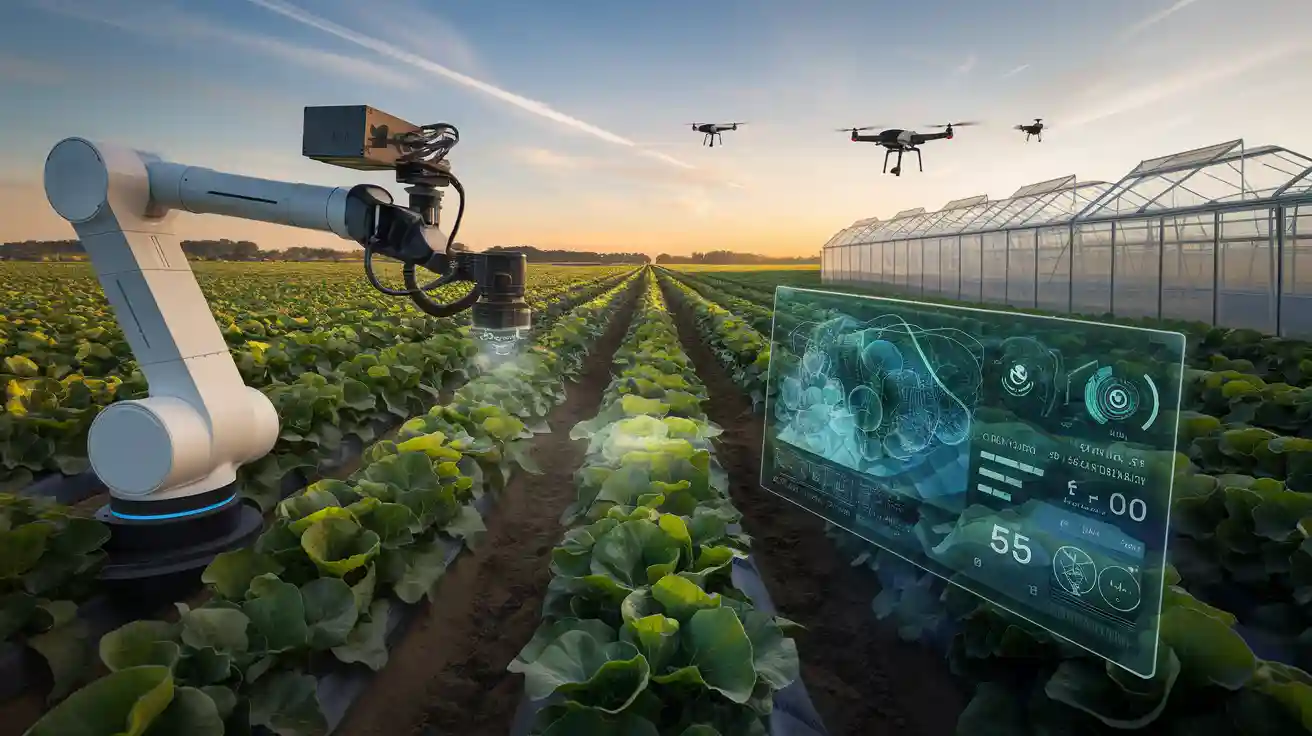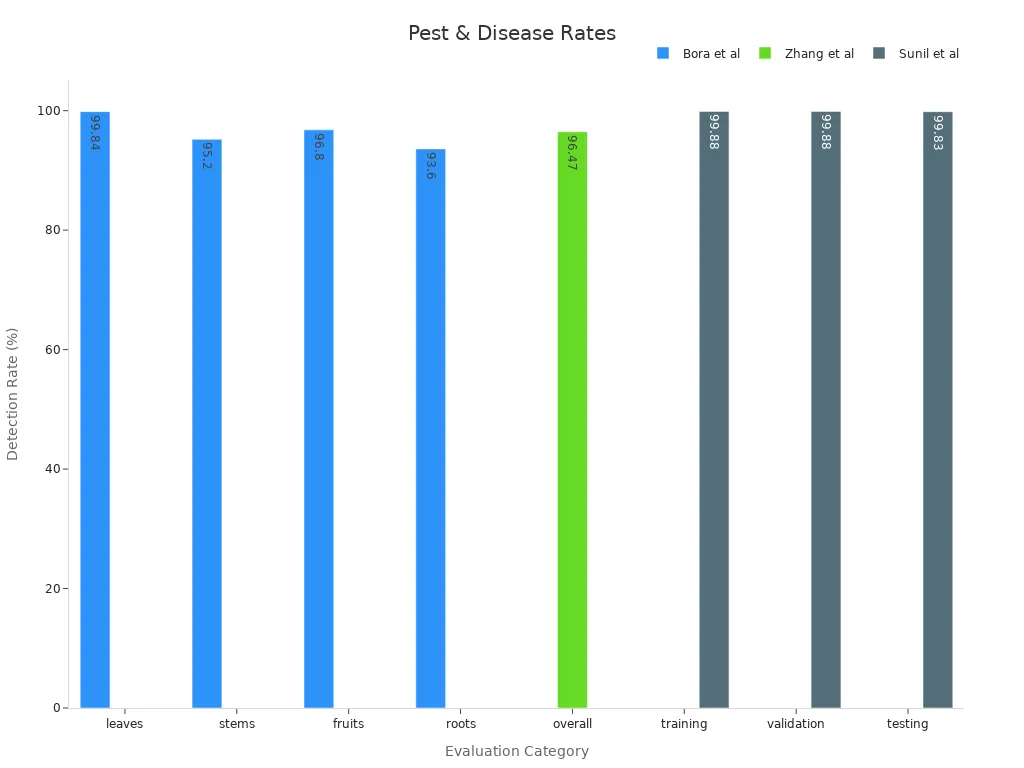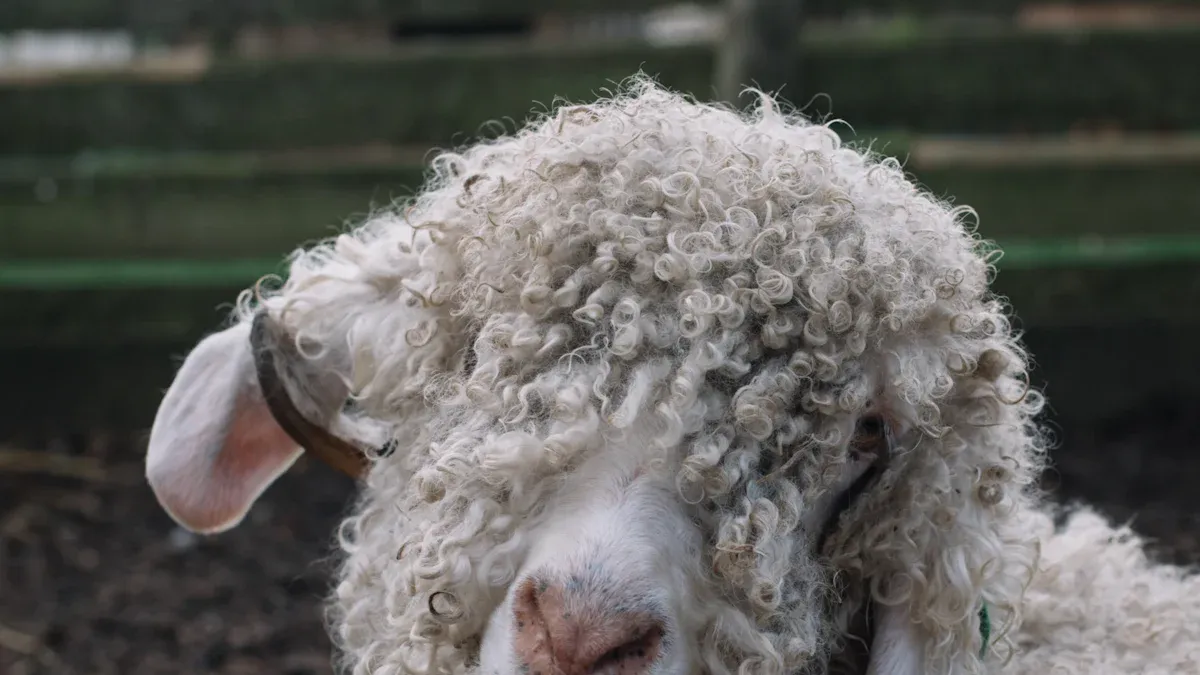Why Agriculture Machine Vision Systems Are Game-Changers

Agriculture machine vision systems are reshaping farming practices by improving accuracy and efficiency. These systems use advanced technologies to monitor crops, detect pests, and optimize resource use. For example:
- Precision agriculture has boosted U.S. crop yields by 4% since 2021, with potential increases up to 6% as adoption grows.
- Machine vision enables timely harvesting, ensuring high-quality produce and healthier crops.
By reducing losses from pests and weeds, which cost billions annually, you can achieve sustainable farming while protecting the environment.
Key Takeaways
- Machine vision systems help farming by making work faster and better. This leads to more crops being grown.
- These systems do jobs like watching crops and finding pests. They save time and cut down on work costs.
- Drones check crops quickly and give updates. This helps farmers decide wisely and use resources well.
- Machine vision supports eco-friendly farming by reducing waste and saving resources. This helps the planet and makes farms earn more.
- Adding AI and IoT will improve farming in the future. It will make farm work easier and better for the environment.
Understanding Agriculture Machine Vision Systems
Definition and Role in Agriculture
An agriculture machine vision system is a cutting-edge technology that uses image processing and analysis to automate farming tasks. These systems combine cameras, sensors, and artificial intelligence to monitor crops, detect pests, and assess plant health. By automating these processes, you can save time, reduce labor costs, and improve productivity.
Machine vision plays a vital role in modern agriculture by enabling precision farming. It allows you to monitor crop growth, measure distribution, and even count produce. For example, these systems can inspect plants for diseases or pests and provide real-time data to help you make informed decisions. This automation ensures that farming becomes more efficient and sustainable.
Did you know? Machine vision applications can extract quantitative features like plant color, shape, and size from images. These features can be compared with manually measured growth parameters, giving you accurate insights into crop health.
How They Work: Cameras, Sensors, and AI
Agriculture machine vision systems rely on a combination of cameras, sensors, and AI to function effectively. Cameras capture high-resolution images of crops, while sensors collect additional data, such as temperature, humidity, and soil moisture. AI algorithms then analyze this information to identify patterns, detect issues, and provide actionable insights.
For instance, drones equipped with advanced imaging technologies can scan large fields and detect early signs of crop stress. These systems use computer vision to differentiate between healthy plants and those affected by pests or diseases. In weed management, machine vision can distinguish crops from weeds, allowing you to target weeds with precision and reduce herbicide use.
Robots with vision systems also play a significant role in harvesting automation. They scan crops in real-time to identify ripe produce, ensuring timely and efficient harvesting. Additionally, machine vision systems can predict crop yields by analyzing images, helping you plan production and resource allocation.
Pro Tip: Precision irrigation is another remarkable application of machine vision. By analyzing crop images, these systems can optimize water usage, ensuring your plants receive the right amount of water at the right time.
The integration of cameras, sensors, and AI in agriculture machine vision systems has revolutionized farming. These technologies not only improve efficiency but also promote sustainability by reducing waste and conserving resources.
Precision Agriculture with Machine Vision Applications
Enhancing Crop Health Monitoring
Machine vision systems revolutionize crop health monitoring by providing real-time data on plant conditions. These systems analyze images to detect subtle changes in plant phenotyping, such as color, shape, and size. By identifying these variations, you can assess crop health and take timely action to improve yield and harvest quality.
Several studies highlight the effectiveness of machine vision in crop monitoring:
- The study "Improving crop production using an agro-deep learning framework in precision agriculture" demonstrates how predictive modeling enhances agricultural yield.
- Ahmed et al. show that monitoring growth stages helps optimize irrigation and fertilization, leading to better crop health.
- Dixit et al. focus on detecting wheat crop diseases, enabling timely treatment and improved productivity.
Machine vision applications also support crop yield prediction by analyzing phenotypic traits. This predictive capability helps you plan resource allocation and harvesting automation, ensuring efficiency gains across your operations.
Tip: Use drones equipped with machine vision systems for large-scale crop monitoring. They provide detailed insights into plant health, saving time and resources.
Pest and Disease Detection
Machine vision systems excel at identifying pests and diseases early, preventing widespread damage to crops. These systems use AI-powered algorithms to analyze images and detect abnormalities in leaves, stems, fruits, and roots. Early detection ensures timely intervention, reducing losses and improving harvest quality.
Empirical studies reveal impressive success rates for pest and disease detection:
| Model | Detection Rate (%) | Specifics |
|---|---|---|
| Bora et al. (2023) | 99.84% (leaves), 95.2% (stems), 96.8% (fruits), 93.6% (roots) | Tomato disease detection |
| Zhang et al. (2023) | 96.47% | Based on 3123 images |
| Sunil et al. (2023) | 99.88% (training), 99.88% (validation), 99.83% (testing) | Multi-Feature Fusion module |

Machine vision systems not only detect pests but also classify diseases, enabling targeted treatments. This precision reduces the need for excessive pesticide use, promoting sustainable agriculture practices.
Optimizing Resource Use
Machine vision systems optimize resource use by improving equipment utilization, reducing operational costs, and enhancing efficiency. These systems analyze real-time data from IoT sensors and onboard diagnostics to ensure machinery operates at peak performance.
Key metrics for resource optimization include:
| Metric | Description | Measurement Approach | Key Benefit |
|---|---|---|---|
| Equipment Utilization Rates | Active usage rate of machinery | IoT Sensors, Telematics | Ensures machinery is fully leveraged |
| Output Analysis | Productivity per machine | Yield per operational hour | Direct indicator of ROI on equipment |
| Maintenance Schedules & Downtime | Frequency and duration of downtime | Maintenance logs, Onboard diagnostics | Minimizes operational interruptions |
| Cost per Unit of Operation | Financial cost per operation unit | Expense reports and yield data integration | Streamlines budgeting and cost management |
By leveraging machine vision systems, you can reduce waste, conserve resources, and achieve efficiency gains. For example, autonomous tractors equipped with machine vision ensure precise planting and harvesting, minimizing fuel and labor costs.
Pro Tip: Integrate machine vision with IoT systems for real-time monitoring of machinery and crops. This combination enhances automation and boosts overall productivity.
Real-World Applications in Agriculture

Crop Monitoring and Analysis
Machine vision systems have transformed crop monitoring into a precise and efficient process. These systems use drones equipped with cameras and sensors to capture detailed images of fields. You can analyze this data to assess crop health, map growth patterns, and predict yields. For example, drones provide geo-sensing information that helps you plan planting and harvesting schedules.
Yield estimation is another critical application. By analyzing phenotypic traits, machine vision systems predict harvest quantities, allowing you to allocate resources effectively. Agricultural drones also perform tasks like pest control and planting, showcasing their versatility in smart farming.
| Application | Description |
|---|---|
| Crop Monitoring with Drones | Drones capture large amounts of data with built-in cameras, providing insights for mapping and planning crop yields based on geo-sensing information. |
| Yield Estimation | Helps in preharvest practices by providing accurate yield predictions, which are crucial for logistics and resource allocation. |
| Agricultural Drones | Drones perform various tasks such as planting, pest control, and crop monitoring, showcasing their versatility in smart farming. |
Tip: Use drones for real-time crop monitoring to save time and improve decision-making.
Automated Harvesting Systems
Automation in harvesting has revolutionized agriculture. Autonomous robots equipped with machine vision systems work tirelessly to improve yield rates and profit. These systems assess indicators like size, skin color, and firmness to determine the best time for harvesting. Hyperspectral imaging further enhances quality control by classifying fruit sweetness and nutrient richness.
Inline quality inspections ensure only premium produce is processed. By sorting out defective items, these systems minimize supply loss and improve harvest quality. Autonomous tractors equipped with machine vision also contribute to efficient harvesting, reducing labor costs and maximizing productivity.
- Autonomous harvesting robots improve yield rates and profit by working around the clock without fatigue.
- Machine vision systems assess indicators of peak maturity, ensuring optimal picking times.
- Hyperspectral imaging enhances quality control by classifying fruit sweetness and nutrient richness.
- Inline quality inspections minimize supply loss by sorting produce based on defects.
Pro Tip: Implement autonomous harvesting systems to boost efficiency and ensure high-quality produce.
Livestock Management Solutions
Machine vision systems are not limited to crops; they also enhance livestock management. Advanced models like BiAF-YOLOv7 improve monitoring efficiency and accuracy, especially in complex environments. These systems track multiple animals simultaneously, ensuring over 90% accuracy even in challenging conditions.
You can use machine vision to monitor animal health, detect abnormalities, and optimize feeding schedules. This automation reduces labor costs and improves overall farm efficiency. The BiAF-YOLOv7 model has shown significant improvements in precision, recall, and mean Average Precision (mAP), making it a reliable solution for livestock management.
- The BiAF-YOLOv7 model improves precision by 5.8%, recall by 4.5%, and F1 score by 5.7%.
- It achieves over 90% tracking accuracy, even in complex environments.
- Previous methods struggled in challenging conditions, but BiAF-YOLOv7 addresses these issues effectively.
Note: Machine vision systems help you monitor livestock health and behavior, ensuring better farm management.
Challenges and the Future of Agricultural Machine Vision
Current Limitations: Cost and Adoption Barriers
Machine vision systems in agriculture face significant challenges, particularly in cost and adoption. The upfront investment required for these systems often deters small and medium-sized enterprises (SMEs). While individual components like cameras and sensors have become more affordable, the overall cost remains high due to the need for specialized hardware, software licenses, and integration services. Customization further increases expenses, as it demands engineering expertise and extended development time.
Technical know-how presents another barrier. Implementing machine vision requires knowledge in optics, lighting design, and image processing. Many farms lack these skills, forcing them to hire external specialists, which adds to the financial burden. Integration with existing systems can also be complex, leading to indirect costs that strain tight profit margins.
Note: Reducing costs and simplifying integration processes will be crucial for wider adoption of machine vision systems in agriculture.
Future Trends: AI and IoT Integration
The future of agricultural machine vision lies in the integration of AI and IoT technologies. AI-enabled drones already provide detailed data on crop conditions, helping you manage fields more effectively. Satellite imagery offers real-time insights into crop health, while field sensors monitor environmental factors like soil moisture and temperature. These systems feed data into AI models, enabling precision agriculture and optimizing resource use.
Predictive analytics powered by AI is transforming farming. It forecasts crop yields and anticipates outbreaks of pests or diseases, allowing you to take preventive measures. IoT integration enhances irrigation systems by collecting real-time data and refining water usage based on historical weather patterns and soil analysis. This smart approach ensures efficient resource allocation and reduces waste.
Tip: Embrace AI and IoT technologies to stay ahead in modern farming. These innovations will drive the future of agricultural machine vision, making your operations more efficient and sustainable.
Agriculture machine vision systems are transforming farming into a more efficient and sustainable practice. By adopting these technologies, you can monitor crops with unprecedented accuracy, detect pests early, and optimize resource use. Studies show that deep learning achieves 84.95% accuracy in pest classification, reducing environmental impact and improving yields. Farmers using precision agriculture have reported profit increases of up to 120%. Expanding sustainable practices to 40% of farmland could also help mitigate climate change. These advancements make machine vision an indispensable tool for modern farming.
FAQ
What is the main benefit of using machine vision systems in agriculture?
Machine vision systems improve efficiency by automating tasks like crop monitoring and pest detection. You save time, reduce costs, and increase productivity. These systems also promote sustainability by optimizing resource use and minimizing waste.
Are machine vision systems suitable for small farms?
Yes, but cost can be a challenge. Affordable options like drones and basic sensors are available. You can start small and scale up as your farm grows. Many systems offer modular designs to fit your needs.
How do machine vision systems detect pests and diseases?
These systems use AI to analyze images of plants. They identify abnormalities like discoloration or unusual patterns. Early detection allows you to treat issues before they spread, protecting your crops and improving yields.
Can machine vision systems help reduce water usage?
Absolutely! These systems analyze crop images to determine water needs. Precision irrigation ensures plants receive the right amount of water at the right time. You conserve resources and avoid overwatering, which can harm crops.
What skills do you need to operate machine vision systems?
Basic knowledge of technology helps, but many systems are user-friendly. Training programs teach you how to use cameras, sensors, and software. If needed, you can hire specialists for setup and maintenance.
See Also
Comparing Firmware Machine Vision With Conventional Systems
Exploring Machine Vision Inspection Systems For 2025
An Overview Of Cameras Used In Machine Vision
